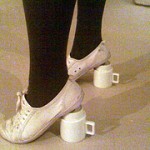March is Women’s History Month, and today is International Women’s Day, devoted to celebrating the economic, social, and political achievements of women, past, present, and future. In fact, this year is a banner year, being the centennial celebration (1911-2011.)
My favorite saying about women in history is “well-behaved women rarely make history.” Translate this adage through the lens of this blog: women history-makers were excellent at disputing cultural shoulds.
Any woman who has ever made history began by rehearsing in her head, debating and talking back to the status quo, asking “who says?” before finally moving into execution of her famous act. The kind of questioning that I live by, and hope to encourage through this blog.
Many ill-behaved women have made history by challenging cultural ‘shoulds.’ Rosa Parks didn’t listen to the bus driver order her to give up her seat to a white passenger. Elizabeth Blackwell and Maria Montessori became the first women physicians(U.S. and College of Rome, Italy, respectively). Who says women had to be nurses? Sally Ride was the first woman in space, topping the accomplishment of a Ph.D. in astrophysics! Who says women can’t do math? And to think that women who applied to be astronauts in the early days of the U.S. space program had to wear high heels and hose during qualifying tests (pre-panty hose, that would mean a garter belt, too!) That brings to mind another adage about women in history: “Don’t forget Ginger Rogers did everything (Fred Astaire) did backwards . . . and in high heels!”
Psychologist James Prochaska has determined that there are stages in the intellectual process of change, steps we must engage in before we can finally act. These stages are precontemplation, contemplation, preparation, action, and maintenance. Stroll through the lists of women in history, and imagine the challenges to traditional thinking that were necessary precursors to action. I’m guessing that considerable time was spent contemplating those changes, revising a few assumptions, before these women came close to preparation and action.
We need to cut ourselves some slack if our process of talking back to the status quo, in society or our own heads, takes some time. Find your own pace, time to contemplate and prepare. And maybe, in honor of International Women’s Day, forget being well-behaved and make a little history of your own today. Join the ranks of the history-makers by revving up the chorus of ‘who says?’ in your life.
Talk back–and tell me how you honored the tradition of the day.





